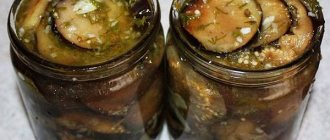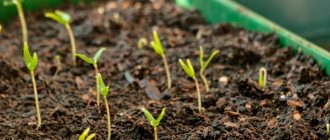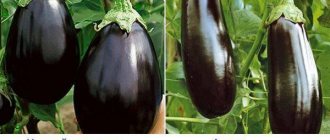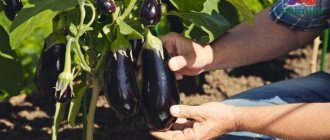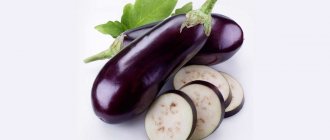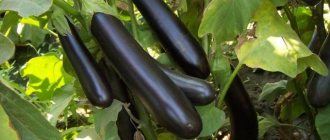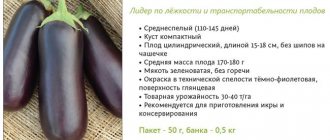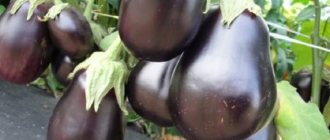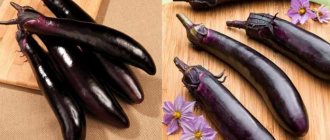French vegetable hybrids are distinguished by their high quality, productivity, and adaptability to open and closed ground. All these features are inherent in the Fabina F1 eggplant hybrid. Its fruits have a classic color and shape, they are very fast, transportable, and suitable for sale and cultivation in personal gardens.
| Origin | Landing location | Ripening period | Fruit color | Fruit weight | Fruit shape |
| Hybrid | Open ground | Mid-season | Dark purple | 162-218 | Cylindrical |
Description and characteristics of the variety
The Fabina eggplant variety was developed in France about 20 years ago. Initially, eggplants of any kind were cultivated only in the southern regions of Russia. But over time, they began to be grown in the central regions, and then in the northern regions. In 2007, the State Register of the Russian Federation approved the Fabina variety for cultivation in the North Caucasus District.
Did you know? Only culinary specialists classify eggplant as a vegetable crop.
-
according to the botanical classification, these fruits are berries.
The described plants are of medium height (about 60 cm), spreading type, which allows them to be placed according to a 100x40 cm pattern. The main feature of this variety is the ability of the bush to withstand a load of up to 9 fruits without garters and additional supports. The shoots are covered with large green leaves with grooved edges. Young plants do not tolerate sudden temperature changes well, so seedlings should be planted in open ground starting from May 25th.
The flowers are large, bisexual, 2.5–5 cm in size. They are arranged singly or form inflorescences, including from 2 to 7 flowers.
Advantages and disadvantages of a hybrid
hybrid has a number of advantages over other species :
- does not require additional support for the bush;
- early and friendly ripening of fruits;
- long fruiting period;
- unpretentious to temperature conditions;
- not susceptible to diseases;
- beautiful appearance of the fruit;
- almost complete absence of seeds;
- good keeping quality.
The disadvantages of the hybrid include the presence of thorns on the calyxes of the fruit and the requirement for watering.
Photo gallery
The fruits are large, elongated-cylindrical in shape. The length of an eggplant that has reached technical maturity can vary between 20–23 cm, less often 25 cm. The diameter of the fruit is 5–6 cm. The skin is dense, thin, purple in color, has a smooth structure, without depressions or tubercles. The pulp is white with a soft green tint. The structure of the pulp is dense and juicy.
The variety is genetically devoid of bitterness. The taste of the pulp is very tender, it literally melts in your mouth. The fruits are characterized by good shelf life, up to 90%, and resistance to mechanical damage, which allows them to be transported over long distances.
The fruits are actively used in cooking, mass production of dietary food and winter preparations, as well as in commercial activities.
The variety is resistant to verticillium wilt and spider mites, which greatly simplifies cultivation and care. In field conditions, Fabina f1 bears fruit before frost.
Description of the fruit
The eggplant bush of the Fabina variety produces multiple fruits of an elongated cylindrical shape, the skin of which is painted in a deep dark purple hue. By the time the vegetables reach technical ripeness, a characteristic glossy shine appears on the surface of the fruit.
Another advantage of the variety is that the fruits are uniform in size - they reach a length of 22 cm, with a diameter of about 6 cm. A ripe eggplant boasts a thin and delicate skin covering dense, slightly greenish flesh, which is absolutely not characterized by a bitter aftertaste.
Cultivation care
The greatest productivity of the variety is observed when grown by seedlings. Seeds are planted in a common container at a distance of 3–5 cm from each other. The seed germination mixture is prepared from:
- 3 parts garden soil;
- 2 parts peat;
- 1 part sand.
For 10 kg of soil mixture add 2 tbsp. l. with a pile of wood ash. Soil moisture for seed germination should be about 70%. After planting, the container with the seeds is covered with film and left for 10 days in a dark room with an air temperature of +27°C. Periodically, the plantings are ventilated, removing the cover for 15 minutes, and if necessary, spray the soil with water. When the sprouts appear, the film is removed and the container is moved to a lighted windowsill. With the appearance of 2 true leaves, the seedlings are planted into separate containers or peat cups using the transshipment method. Seedlings are planted in a permanent place after the appearance of 3-4 full leaves.
Eggplants should not be planted after nightshades and potatoes. It is better to give preference to areas where legumes grew.
If the plot is not so large, then after the nightshades it is necessary to cultivate the soil, and then sow rye or winter wheat. 2 weeks before frost, the soil is cultivated and by spring a cleared area is obtained, fertilized with rotted plant material. The ideal place for growing eggplants is an area protected from drafts and winds, well lit by the sun. Eggplants bear fruit best on loamy and sandy soils.
Find out what to do if your eggplant leaves are wilting.
The site is being prepared in the fall. First, all weeds are removed, then they are dug to a depth of 20 cm and sprayed with a solution of copper sulfate. A week later, 10 kg of fresh manure is added to each m² and dug up again to a depth of 20 cm. In the spring, a similar procedure is carried out, only copper sulfate is replaced with “Fitosporin-M” (the drug is diluted with water 1:2 and infused for 1 hour), and instead of fresh rotted or dry manure is used. When transplanting, add 1 tbsp to each hole. l. wood ash or 50 g of superphosphate.
Immediately after planting in a permanent place, the seedlings need to be watered, approximately 0.5 liters per bush. When the liquid is absorbed and the soil dries out a little, you need to loosen and mulch the soil. You can use compost or fresh juicy grass as mulch. The mulch layer should be at least 8 cm. This technique will preserve moisture in the soil and protect the plantings from pests and diseases. Loosening of the soil is carried out after each watering and rain.
Watering is carried out once a week for young plants and once every 10–12 days for adults. During the active fruiting stage, the intensity of watering is again increased to once a week. The water should be warm and not differ in temperature from the environment by more than 5°C. Watering is carried out at the root using a watering can with a long nose. Sprinkling is contraindicated for this crop.
Important! Moisture on leaves negatively affects plant immunity.
Stagnation of moisture in the leaf axils leads to the appearance of rot on the shoots. Fertilizers are applied only 3 times throughout the season:
- 10 days after planting in a permanent place - 40 g of urea per 1 m² or 0.5 l of liquid mullein solution;
- 20 days after the first - 5 g of potassium salt and 40 g of superphosphate per 10 liters of water;
- at the stage of fruit set - yeast solution (25 g of yeast per 10 liters of water + 1 tbsp. sugar).
Fabin bushes do not form too many well-developed lateral shoots, which are located at a sufficient distance from each other. This allows you to completely abandon the bush formation procedure. The bushes also do not require supports, but if more than 9 ovaries are left on them, then slingshot-shaped sticks should be placed under the fruiting branches.
Landing
Seeds are sown in February-March. Prepare a nutrient substrate according to the recipe:
- 3 parts of land from the garden;
- 2 parts lowland peat;
- 1 part sand or perlite;
- Add half a glass of wood ash to 10 kg of mixture.
Calcinate the composition in the oven at a temperature of +100 degrees for 15 minutes. You can instead spill it with a solution of potassium permanganate.
When planting, soil moisture should be 70%.
It is recommended to plant seedlings in individual peat cups. This will help minimize root trauma during picking and transplanting.
Plant in common containers according to a 3-5 by 3-5 cm pattern. Water, cover with film or glass and place in a room at a temperature of +26-27 degrees. The plantings are ventilated every day by lifting the film for 15-20 minutes.
When the shoots appear, open the containers and transfer them to a well-lit windowsill. The duration of daylight hours should be 12-14 hours.
Seedlings are planted on the plot when they produce 3-4 true leaves, and ideally 6-10 leaves and the first buds.
The bed is prepared after legumes or pumpkin crops, onions, herbs, carrots, cabbage, and radishes. Cannot be planted after other nightshades for 3-4 seasons. In the fall, the site is dug up, fertilized with organic matter, and, if necessary, the acidity is reduced.
Planting pattern - 40 by 100 cm.
Diseases and pests
Failure to comply with agrotechnical rules leads to infection of the plant with the following fungal diseases:
- Phytophthora - progresses in conditions of high humidity. The disease can be overcome by removing 5 cm of soil and replacing it with a mixture of peat and sand (1:1), removing the affected parts of the plant and treating with a 3% solution of Bordeaux mixture 3 times with an interval of 20 days.
- White rot - affects the roots of young seedlings planted in cold soil. To save the plants, you need to remove the affected branches, leaves and dust the plants with a dry mixture of wood ash and Fundazol (1:1). After 10 days, treatment is carried out with a 3% solution of Bordeaux mixture.
- Anthracnose is transmitted when crop rotation is not observed. Treatment with a 0.3% HOM solution will help save the plants.
Among the pests dangerous to Fabina eggplants are:
- Colorado potato beetle - eliminated by several sprays with a solution of the drug "Aktara" (8 g/10 l of water);
- mole cricket - against the insect, use the remedy “Medvetox” (the substance must be buried 4 cm into the soil).
Fabina, old-timer of French hybrids
Fabina eggplant is a hybrid form obtained in France. Originator Clause.
In 2007, the variety (hybrid) was included in the State Register of Varieties of the Russian Federation, recommended for cultivation in open ground, the recommended cultivation region is the North Caucasus.
A promising form for commercial cultivation, for household plots, cultivated indoors, in field conditions.
Characteristics: early, productive, precocious
Ripening dates are early (mid-early) - the growing season is up to 70 days. The fruiting period is long. Ripening is early: at technical ripeness, the fruits are harvested almost after the earliest Bibo and Galine.
Advice! It is important to quickly remove fruits that have reached ripeness, so as not to delay the ripening of the rest and the development of a new ovary.
The technical ripeness of eggplant is determined by the intense gloss and small, almost impalpable seeds of hybrids. When fully ripe, the gloss of the peel fades, the flesh takes on a yellowish tint, and the seeds become coarser and enlarge.
The photo shows eggplants Fabina F1: growing in a greenhouse. Characteristics of the French hybrid.
Productivity is high: industrial productivity is 306-355 c/ha, approximately more than 7 kg/m2, according to other data, about 600 kg per hundred square meters. The yield of marketable fruits is 99%.
Fruiting is consistent and long-lasting: in field conditions, harvesting continues until frost in October-November.
In comparison with the standard (reference) varieties Almaz, Lebediny (242-340 c/ha) it is quite high, which allows the hybrid to be used on commercial areas, incl. to obtain early products.
Morphological description
- Plants are erect, semi-spreading bush, from medium to tall - in open ground from 45 cm to 0.7 m, in a greenhouse up to 0.8 m.
- The stems are strong, powerful, slightly pubescent, with a faint anthocyanin tint.
- The leaf is medium-sized, green, without thorns. Internodes are short.
- The fruits are dark purple, cylindrical, of regular elongated shape, length from 12-15 to 25 cm, diameter from 5-7 cm and above, with small spikes on the calyx, ripen 6-8 pieces at a time.
- The skin has an intense gloss, strong but not rough.
- Weight 162-208 g (declared), in fact and according to reviews, individual fruits reach 350-400 g or more.
- The fruits have an excellent oily taste, with whitish dense pulp, completely devoid of bitterness, with a thin, delicate skin.
- And - they are practically devoid of seeds - the main advantage of eggplant hybrids over varieties that, when fully ripe, are distinguished by hard, coarse seeds, yellowing and coarse flesh.
Disadvantages:
- Small spines on the calyx of the fruit;
- Requirement for watering;
- Moderate yield compared to industrial varieties;
- With insufficient watering, in the heat the peel becomes bitter and excessively dense.
Among the advantages:
In terms of the totality of qualities, it is one of the best hybrids in its class, despite its shortcomings. Early ripening, with delicate skin and snow-white pulp without bitterness, ideal teardrop shape, productive - this is what many experienced vegetable growers think.
Agrotechnics of cultivation
Seeds are usually characterized by high germination and excellent germination speed - no more than 7-10 days, which is an excellent result for the crop as a whole.
In open ground, planting according to a pattern of 50 x 50 cm or more when planting in a checkerboard pattern, when planting in rows of 100 x 40-35 cm.
There are no more than 5 plants per 1 m2: plants that simultaneously bear several kilograms of crops need a large feeding area and good lighting. Needs a garter - to high stakes, stretched wires.
Fabina eggplant is considered relatively demanding when it comes to fertilizing - again, due to its high productivity, a large number of simultaneously ripening fruits - about 7 pieces. At the first stages, nitrogen fertilizers are applied, during flowering and ovary - potassium fertilizers, microelements, incl. boron
Collection and storage
Harvesting should begin when the fruits have reached technical maturity. They are cut with a sharp knife along with the stalk. This approach allows you to make room for new ovaries and fully unlock the plants’ potential in terms of yield. Subsequently, the fruits are harvested as they ripen, approximately every 10–14 days.
Important! Overripe fruits accumulate solanine, so you should not leave them on the branches for a long time: consuming such products can cause poisoning.
Eggplant is not a vegetable crop for long-term storage; it is better to immediately send the fruits for processing. But if there are a lot of products, you can put them in a deep box in a loose layer and cover them with wood ash. In dry, cool rooms with a relative humidity of 50% and an air temperature of up to +7°C, they can be laid out directly on the floor on straw. When using such methods, there are no guarantees determining the duration of storage: vegetables can lie for 2 weeks without losing their qualities, or they can be stored for 2 months. It is still better to prefer dry freezing or canning, and store fresh eggplants for no longer than 2 weeks.
The Fabina f1 eggplant variety is attractive due to its high yield, relative ease of care and ability to adapt to different microclimatic conditions. If all the rules of agricultural technology are observed, the crop is practically not affected by diseases and pests.
Reviews from those who grew
Summer residents are satisfied with the yield and taste of the hybrid , as they say in their reviews.
Victor, Rostov region : “The hybrid is distinguished by its super-yielding and early ripeness, without the frequency of fruiting - just have time to remove the mature fruits so as not to delay the development of new ovaries. Eggplants are without bitterness, very tasty and tender.”
Svetlana, Tula : “This year I’m growing eggplants for the first time. I've been collecting Fabin F1 eggplants for 2 weeks now. I liked the taste, without bitterness, and the skin is thin, it does not interfere at all when frying or stewing.”
Rules for agricultural technology of the Fabina variety in open ground
Soil structure and good drainage are very important for growing eggplants. On heavy clay soils, Fabina will not produce a good harvest, and the seedlings may well die completely. The soil must be prepared in the fall before plowing - add rotted manure. Eggplants grow better after melons and legumes. But you can’t plant blueberries after tomatoes or potatoes, because this group of plants suffer from the same infectious diseases and are affected by the same insects.
Eggplants for growing in the Urals
In addition to the “northern” varieties, there are also “Ural” varieties. Despite the heat-loving nature of the crop, you can still get a high-quality harvest here.
Diamond
The variety is characterized by low bush growth (no more than 55 cm). Eggplant Almaz feels great in different conditions: in a greenhouse, in a greenhouse, and in a garden bed. The fruits appear after 110 days. The length of an adult eggplant is 17 cm, and the weight is 150 - 160 g. They have excellent taste. There is sweetness. The flesh is green and quite dense. Productivity – up to 7.5 kg per 1 m2.
White Night
An early variety of unusual white color is compactly placed at the planting site. The shape of the fruit is slightly curved and looks like a cylinder. The height of the bushes is no more than 50 cm. But the yield is high (up to 6 kg per 1 m2). The taste is mild, without the presence of bitterness. The peel is thin and smooth.
King of the F1 market
Has much in common with the hybrid King of the North. For a good harvest, it is necessary to plant the seeds for seedlings in February or early March. This is a medium ripening variety. It is often grown commercially for sale. The fruits are attractive and can be stored for a long time. Inside, the snow-white pulp tastes sweet. Suitable for canning.
Eggplant Behemoth F1
The light lilac glossy fruits of this mid-season hybrid grow on average up to 20 cm in length, acquire a cylindrical shape with a pronounced thickening downwards, their diameter is 5-10 cm, and their weight exceeds 200 g. What is very nice is that these eggplants do not taste bitter at all.
The bush grows quite compact and does not take up much space in the garden bed. In addition to its high yield, the Behemoth F1 hybrid is notable for its resistance to Verticillium wilt and tobacco mosaic virus.
| Growing | Ripening time (days) | Fruit weight (g) | Bush height (cm) | Productivity (kg/sq.m) |
| 90 | 230 | 50-70 | Up to 17.3 | |
Eggplant Berinda F1
The bushes of this hybrid boast dark purple oval fruits with a pleasant taste that are well stored and transported. They are great for all types of cooking, including canning.
Berinda F1 eggplants can be grown without film cover.
| Growing | Ripening time (days) | Fruit weight (g) | Bush height (cm) | Productivity (kg/sq.m) |
| 91-105 | 280-360 | 100-120 | 13-14 | |
How to grow eggplant seedlings
The harvest of the Fabin hybrid can only be obtained when grown through seedlings. Sowing seeds and growing seedlings is no different from standard technologies. It must be remembered that eggplant is a heat- and moisture-loving crop, so after sowing it is necessary to ensure the correct temperature - above 16 degrees, and regular watering.
Good seedlings, first of all, are obtained on a good substrate, which can be purchased in stores or made independently from turf soil, sand and humus in a ratio of 6: 1: 4. The seeds are sown to a depth of 2 cm; after good watering, the container is covered with film to create a greenhouse effect.
In order for the seeds to germinate well and evenly, they must be soaked for several hours in a growth stimulator before sowing.
After 2-3 true leaves have appeared on the seedlings, it is necessary to plant the seedlings in individual containers. The stem needs to be buried down to the first leaves. After picking, the seedlings need to be watered well and monitor the temperature in the room; they need warmth - 20-25 degrees. Frail seedlings cannot tolerate drought, so watering must be regular.
Water for irrigation should also be warm - at least 25 degrees. You need to water at the root and avoid getting water on the foliage. The containers must have a hole for the drainage of excess moisture, because excess moisture can lead to the spread of root rot and the death of seedlings.
2 weeks before planting seedlings in open ground, they must be hardened off. This is done by taking the containers outside if the seedlings are growing in a room, or by ventilating them in the case of a greenhouse. In the first days, 1-2 hours is enough, gradually the hardening time is increased to 10-12 hours. At the same time, it is important to ensure that the plants are not in a draft, especially in a greenhouse.
Eggplant Quartet F1
Quartet F1 is a “tenacious” hybrid that is not afraid of drought and bacterial rot. Perhaps the plant itself looks unprepossessing (the bush is no higher than half a meter, small yellow-violet fruits without gloss are the size of a palm), but you can’t complain about the taste of the pulp.
Quartet fruits are suitable for rolling, frying and baking.
| Growing | Ripening time (days) | Fruit weight (g) | Bush height (cm) | Productivity (kg/sq.m) |
| 107-122 | 102-123 | 40-60 | 13 | |
The history of the appearance of eggplant in Russia
Eggplant was brought to Russia from Persia and Turkey only in the 17th century, although in the southern countries the vegetable was known in prehistoric times.
The small-fruited purple crop, which grew in wild spaces, attracted many peoples with its exoticism. But none of them developed a taste for the taste for a long time. After all, a raw vegetable from the bush, belonging to the nightshade family, was completely tasteless and, moreover, even caused a hallucinogenic effect in those who dared to try it. The small-fruited purple eggplant fruit has long attracted people, but they still did not know how to cook it properly
But once, somewhere in a southern kitchen, it was heat-treated along with other vegetables, the wild nightshade opened up like a lush flower, presenting the cooks with an absolute surprise in taste. A delicate piquancy appeared, which transformed the pulp of the fruit and captivated the experimenters. However, a lot of time passed before people learned to cook and properly grow this amazing plant.
The ancient name of the vegetable - “apple of madness” - was gradually forgotten, and in its place word forms appeared related to the places where the vegetable grew wild: Pakistani, Badarzhan, Podlizhan, Aberdzhin, which in Russia were transformed into “eggplant”.
The most productive varieties of eggplant
If you are interested in both the quality of the fruits and their quantity, then the following varieties are suitable for you.
Striped flight
This is a mid-season type of eggplant, which is also high-yielding. It can be used for growing in open and closed ground. The variety is resistant to weather changes, and gardeners love it for its high fruit set in any conditions.
The pulp is tender, there is no bitterness or voids. The harvested crop tolerates transportation well and can be stored for a long time.
Black handsome late
When growing this type of eggplant, you can get the first harvest 130 days after germination. The bush is low, the branches are spreading. Vegetables are pear-shaped, their color is black and purple. One eggplant weighs up to 900 g.
Sophia
This is a late-ripening plant that produces a high yield 130-145 days after germination. The fruit is large, pear-shaped, and dark purple in color. One eggplant weighs 700-800 g. The pulp is light and has excellent taste.
The variety resists negative weather conditions and common eggplant diseases. Sophia is suitable for cultivation in open and closed ground.
